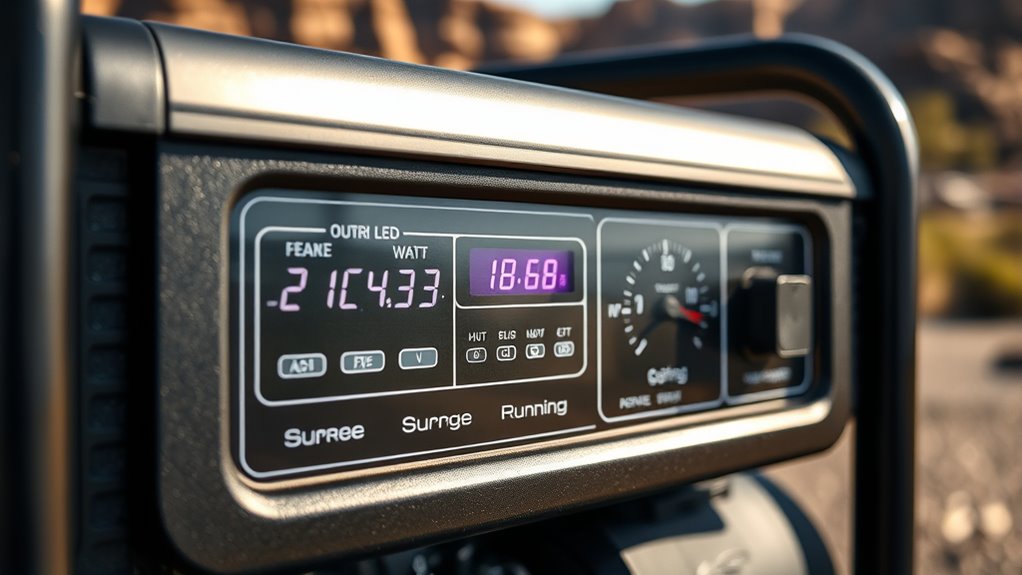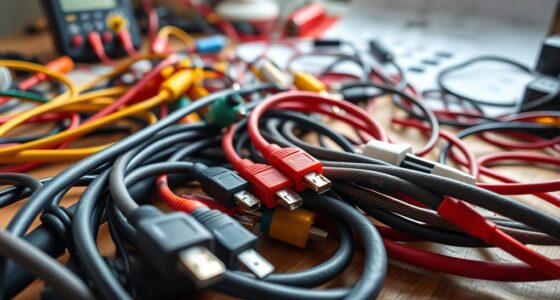Understanding surge versus running watts is key to choosing the right generator. Surge watts are the extra power needed to start appliances like refrigerators or power tools, while running watts are continuous power during operation. Many myths assume peak power equals continuous capacity, which isn’t true. To keep your devices safe and efficient, you need to know both ratings and select a generator that can handle your total load. More details are ahead to help you get it just right.
Key Takeaways
- Surge watts are temporary, high initial power needed to start appliances; running watts are continuous power during operation.
- Many believe surge wattage equals continuous wattage, but they serve different purposes and should not be used interchangeably.
- Proper generator sizing requires adding surge and running watts of all devices, not just peak power ratings.
- Overestimating surge watts can lead to oversized, noisy units; undersizing risks appliance shutdowns or damage.
- Prioritizing both surge and running watt ratings ensures reliable, safe operation of appliances and tools.
Understanding the Basics: Surge and Running Watts Defined
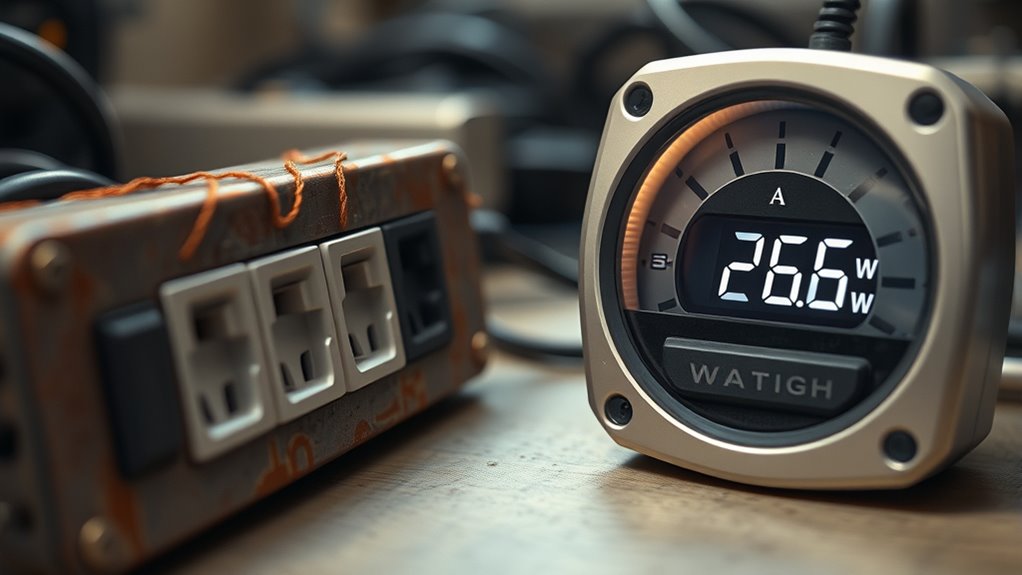
Have you ever wondered what the difference is between surge and running watts? Surge watts are the extra power your generator needs momentarily when starting appliances, like refrigerators or power tools. Running watts, on the other hand, reflect the continuous power your generator supplies during normal operation. Understanding this distinction helps with generator maintenance, guaranteeing you select a unit that meets your needs without overloading it. It also impacts fuel efficiency; a generator running at its appropriate capacity uses fuel more efficiently, preventing unnecessary consumption. Knowing how to differentiate between surge and running watts helps you avoid damage and ensures your equipment operates smoothly. Proper gear selection impacts overall survival success and is essential for emergency preparedness. Ultimately, grasping these basics keeps your generator running reliably when you need it most.
Common Misconceptions About Generator Power Ratings
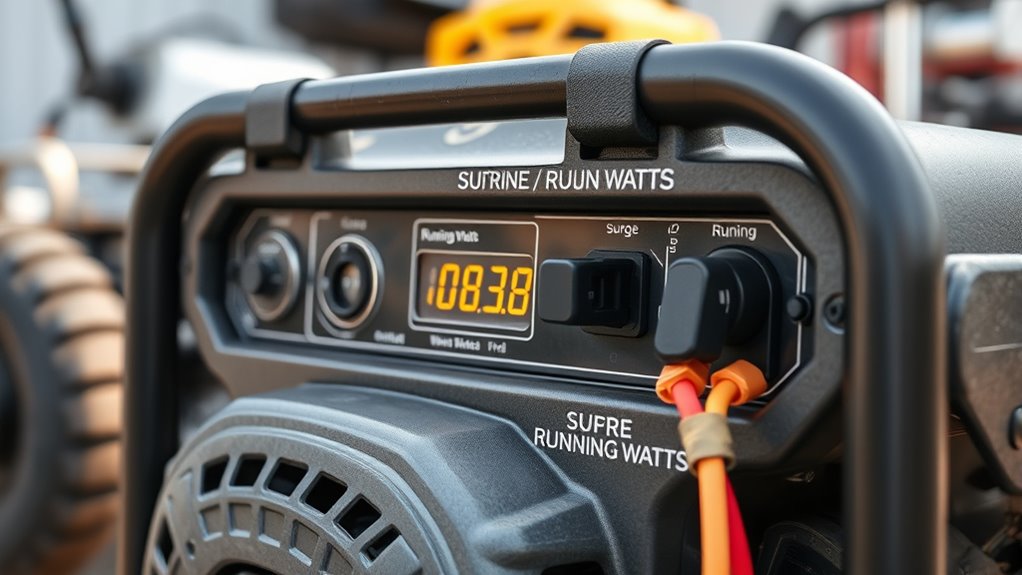
Many people get mixed up about generator power ratings, thinking peak power is the same as continuous power. You might overestimate what your generator can handle if you don’t understand the difference between surge and running watts. It’s common to assume a larger capacity means it can run everything at once, but that’s not always true. Recognizing the role of inspirational quotes can help in understanding the importance of proper power management and safety.
Power Rating Confusion
Understanding the difference between surge and running watts is essential to choosing the right generator, yet many people get confused by these terms. Some believe that the rated power of a generator is the same as its surge capacity, but that’s a misconception. Surge watts are temporary, needed at startup, while running watts are the continuous power output. Misinterpreting this can lead to overloads or inefficient fuel use. To avoid such mistakes and ensure proper generator maintenance, focus on the rated continuous power needed for your devices. Here’s a quick comparison:
| Surge Watts | Running Watts |
|---|---|
| Short-term | Continuous |
| Higher value | Lower value |
| Needed for startup | Needed for operation |
| Not sustainable | Sustainable |
Knowing this helps you select a generator that’s both fuel-efficient and reliable. Additionally, understanding air purifier features and technology can provide insight into how different components impact overall device performance and health benefits.
Peak Vs Continuous Power
A common misconception is that a generator’s peak power and continuous power ratings are interchangeable, but they serve different purposes. Peak power, or surge watts, indicates the maximum power your generator can deliver briefly, typically during startup of appliances with motors. Continuous power, or rated watts, reflects what the generator can sustain over time. Many assume peak power is more important, but relying solely on it can be misleading. It’s vital to consider continuous power for long-term use, especially since operating at or near peak levels can increase noise levels and fuel consumption. Your generator fuel type impacts both power output and efficiency, while noise levels can rise during peak load. Understanding these differences helps you choose a generator that reliably meets your needs without overestimating its capabilities. Understanding power ratings is essential for making informed decisions about generator selection and usage.
Overestimating Generator Capacity
While peak and continuous power ratings are often confused, overestimating a generator’s capacity based on surge watts can cause issues. Believing your generator can handle everything at once may lead to overloads or damage. It’s important to consider proper generator placement, ensuring it’s outdoors in a well-ventilated area to avoid overheating. Also, don’t forget noise level considerations—larger capacity units tend to be louder, which can be disruptive. Relying solely on surge watts might make you think your generator can power more devices than it actually can during continuous use. Always check the running watts needed for your appliances and match them accurately to avoid overloads, reduce noise concerns, and ensure safe operation. Proper sizing prevents unexpected shutdowns and prolongs your generator’s lifespan.
The Role of Surge Watts in Starting Heavy Appliances

Surge watts play a crucial role when starting heavy appliances because they provide the extra power needed to overcome initial resistance. During an appliance startup, such as with refrigerators, air conditioners, or power tools, a sudden power surge occurs as the motor begins to turn. This surge wattage temporarily exceeds the appliance’s running watts, ensuring it can start without issues. Without sufficient surge watts, your generator might struggle to handle the initial power surge, causing the appliance to malfunction or not start at all. Understanding the importance of surge watts helps you select a generator capable of providing the necessary extra power for heavy appliances during startup. In addition, knowledge of zodiac sign compatibility can shed light on how different appliances or devices may have varying power needs based on their characteristics. This ensures reliable operation and prevents potential damage caused by insufficient power during appliance startup.
Why Running Watts Matter for Continuous Power Needs
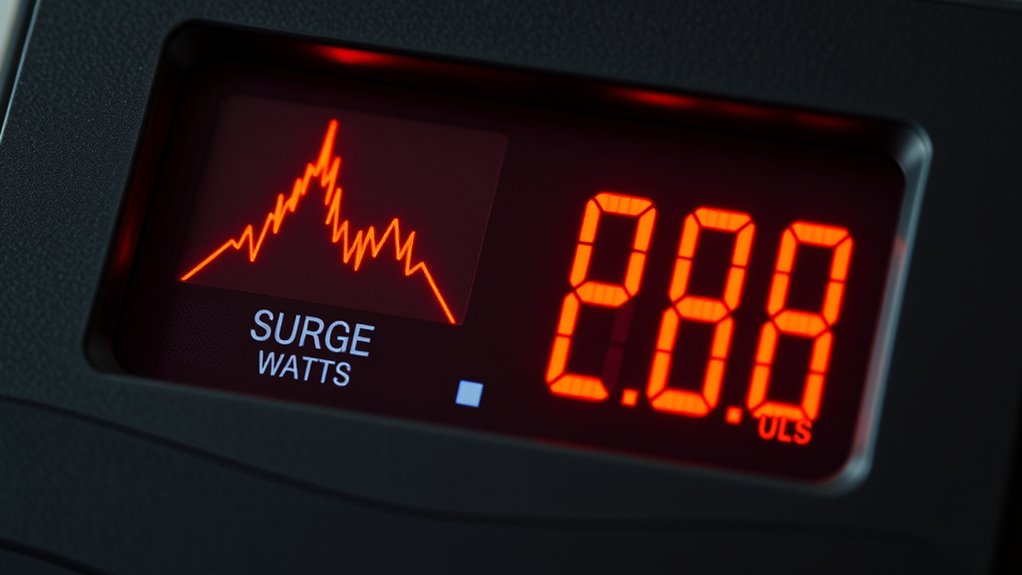
Running watts are essential because they guarantee your appliances operate reliably over time. They support continuous use without interruptions, ensuring your devices stay powered when you need them most. Without enough running watts, you risk power failures that can disrupt your entire setup. Properly understanding power requirements helps prevent issues during operation and ensures safety.
Ensures Reliable Operation
Understanding the importance of running watts is essential for ensuring your equipment operates reliably over time. Running watts determine the continuous power your generator supplies, preventing overloads that can cause shutdowns or damage. Consistent power supports smoother generator maintenance and improves fuel efficiency, saving you money. To manage your power needs effectively, consider the following:
| Power Requirement | Equipment Type | Recommended Watts |
|---|---|---|
| 1000W | Small refrigerator | 1000W |
| 2000W | Power tools | 2000W |
| 3000W | Home appliances | 3000W |
| 5000W | Larger appliances | 5000W |
| 7500W | Whole-house load | 7500W |
Matching your load with running watts ensures reliable operation, reducing strain and extending your generator’s lifespan. Proper load management also helps prevent unexpected outages and prolongs your equipment’s lifespan.
Supports Long-Duration Use
Since continuous power delivery is critical for long-term operations, paying attention to your generator’s running watts guarantees it can handle extended use without interruption. Running watts reflect the power your generator can supply steadily over time, ensuring your appliances and tools keep running smoothly. Choosing a generator with adequate running watts also enhances fuel efficiency, as it operates at dependable levels without overworking. This not only saves fuel but reduces wear and tear, extending your generator’s lifespan. Additionally, a generator with proper running watt capacity tends to run more quietly, lowering noise levels during prolonged use. Proper wattage capacity ensures your setup remains reliable, efficient, and less disruptive during long-duration power needs.
Prevents Power Failures
Ensuring your generator can deliver consistent power is vital to prevent unexpected outages that can disrupt your operations. Running watts determine the continuous power your generator provides, making them essential for power outage prevention. If your generator’s running watt capacity isn’t enough, it may struggle to keep essential systems running smoothly, leading to failures or shutdowns. This can compromise electrical safety and increase the risk of damage to connected devices. By selecting a generator with adequate running watts, you guarantee a steady power supply, reducing the chances of power failures. This reliability keeps your equipment operational and safeguards your environment from electrical issues caused by inconsistent power. Understanding power management helps you avoid interruptions and maintain a safe, stable power source.
How to Calculate Your Power Requirements Accurately
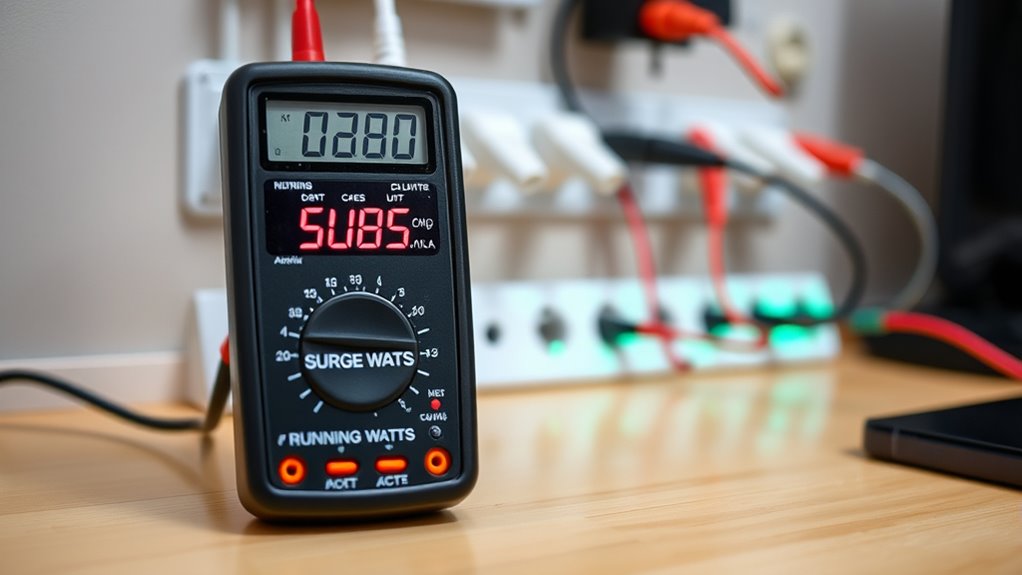
To accurately calculate your power requirements, start by listing all the devices and appliances you plan to run simultaneously. For each item, find its surge and running wattage—usually on labels or in manuals. Add these numbers to determine your total surge wattage, which accounts for startup power, and your total running wattage for continuous use. Remember, choosing a generator with a slightly higher capacity guarantees smooth operation and allows room for additional devices. Regular generator maintenance keeps it running efficiently, optimizing fuel efficiency and preventing unexpected breakdowns. Accurate calculations help you avoid overloading your generator, saving you money and hassle. Additionally, understanding return policies across retailers can save you time and frustration if issues arise with your electronics. By understanding your true power needs, you ensure reliable operation while maintaining fuel efficiency and prolonging your generator’s lifespan.
Choosing a Generator: What Matters Most for Your Devices
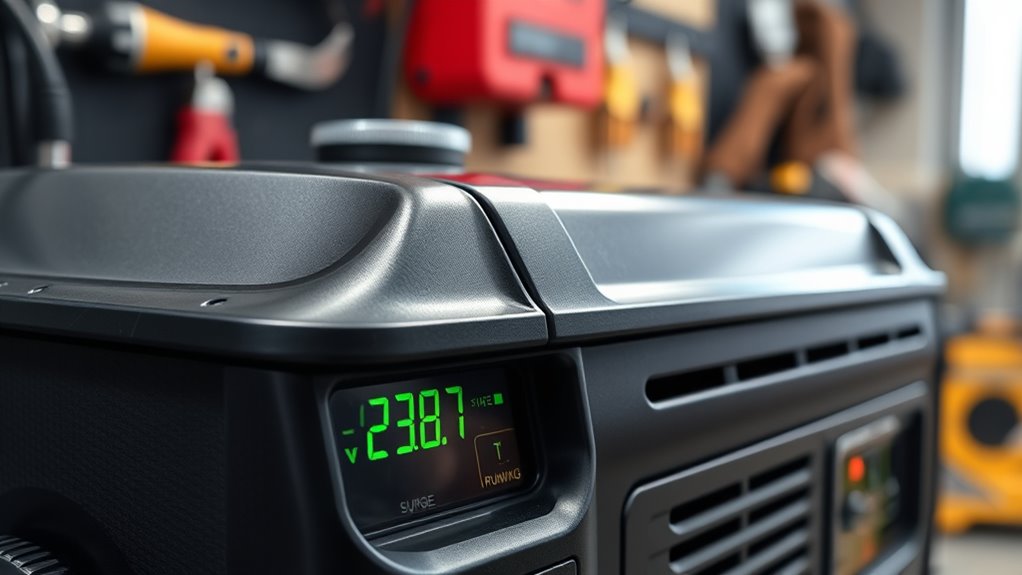
When choosing a generator, the most important factor is matching its capacity to your devices’ power needs, especially during startup. You need enough surge watts to handle initial startup loads without overloading the generator. Equally important are fuel efficiency and noise levels; a more fuel-efficient model saves you money and prolongs operation, particularly during extended use. Look for generators with low noise levels if you’ll be in residential areas or camping sites, as this improves comfort and reduces disturbances. Avoid undersized units that struggle to power your devices, risking damage or shutdowns. Balancing capacity, fuel efficiency, and noise levels ensures you select a generator that reliably supports your devices while operating economically and quietly.
Tips to Avoid Overloading and Maximize Generator Efficiency

Avoiding overloads and maximizing your generator’s efficiency requires paying close attention to how you use it. Effective load management means distributing power wisely and avoiding sudden surges that can strain the system. Always check the starting wattage of appliances and ensure your total load stays below the generator’s capacity. This prevents overloading and reduces wear on the engine. Additionally, managing load helps improve fuel efficiency because the generator runs more smoothly without frequently working at its maximum. Turn off non-essential appliances and stagger startup times to lessen the initial surge. Regular maintenance, such as changing filters and checking oil, also boosts efficiency. By practicing proper load management, you extend your generator’s lifespan and get the most reliable, cost-effective performance.
Frequently Asked Questions
How Do Temperature and Altitude Affect Generator Wattage Ratings?
Temperature effects and altitude impact your generator’s wattage ratings by reducing its performance. When temperatures rise or fall markedly, the engine may struggle, lowering its surge and running watts. At high altitudes, thinner air causes less efficient combustion, decreasing wattage output. You should account for these factors because they can cause your generator to produce less power than its rated capacity, especially in extreme weather or mountain environments.
Can Surge Wattage Damage My Appliances or Generator?
Surge wattage can temporarily exceed your generator’s capacity, but if it’s too high or lasts too long, it could damage your appliances or compromise your generator’s safety. To protect appliance safety, make sure your appliances’ surge wattage stays within your generator’s surge capacity. Always use a surge protector or choose a generator with sufficient surge wattage to prevent potential damage during startup or power surges.
Are Inverter Generators Better for Sensitive Electronics?
Think of inverter generators as the gentle breeze of power—quiet and steady. They’re better for sensitive electronics because they deliver superior power quality, ensuring your devices run smoothly without surges or drops. Plus, their lower noise levels make them a peaceful companion during camping or backup power. You’ll appreciate how inverter generators protect your gadgets and keep noise to a minimum, making them a smart choice for delicate electronics.
How Long Can a Generator Run at Peak Surge Wattage?
You can run a generator at peak surge wattage for only a few seconds to a minute, depending on its surge capacity. This short duration prevents overloads and protects your equipment. Sustained use at surge wattage isn’t recommended, as it can strain the generator’s wattage longevity. Always verify your generator’s surge capacity matches your initial power needs, but rely on running wattage for continuous operation to avoid damage.
What Maintenance Affects a Generator’s Surge and Running Watt Capacity?
You’re only as good as your tools, so keeping your generator in top shape matters. Regular engine maintenance, like changing oil and inspecting spark plugs, directly impacts surge and running watt capacity. Fuel quality also plays a big role; poor fuel can cause performance drops. Neglecting these aspects can lead to reduced power output and potential damage, so stay on top of maintenance for reliable, maximum capacity when you need it most.
Conclusion
Understanding the difference between surge and running watts helps you choose the right generator. Did you know that most appliances typically use about 1.5 times their running watts during startup? By knowing your power needs and avoiding overloads, you can ascertain your devices run smoothly and efficiently. Don’t rely solely on surge ratings—focus on what your appliances actually require for continuous power, and your generator will serve you reliably when you need it most.
